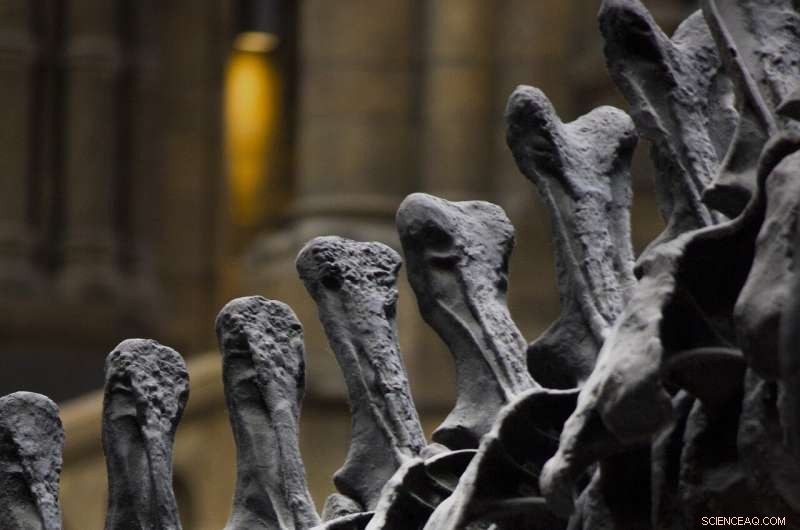
Wetenschap
Onthult dit dinosauruskerkhof hun laatste dag op aarde? Een expert onderzoekt het bewijs

Krediet:Pixabay/CC0 publiek domein
Begraven in de rotsen in North Dakota ligt het bewijs van de exacte dag waarop de dinosaurussen van de planeet werden uitgeroeid, zo'n 66 miljoen jaar geleden. Dat is de bewering van paleontoloog Robert DePalma en collega's, wiens werk werd vastgelegd door de BBC in de recente historische documentaire "Dinosaurs:The Final Day with David Attenborough".
De afgelopen tien jaar heeft DePalma zijn werk geconcentreerd op een fossielrijke plek - die hij 'Tanis' heeft genoemd - in Hell Creek Formation in North Dakota. En sinds 2019 hebben hij en zijn collega's een aantal zeer sterke beweringen gedaan over wat Tanis ons vertelt over het einde van het Krijt.
DePalma gelooft dat Tanis een massakerkhof is van wezens die zijn gedood tijdens de asteroïde-aanval.
Het lijdt geen twijfel dat een asteroïde 66 miljoen jaar geleden leidde tot het massaal uitsterven van niet-vogeldinosaurussen - en minstens 50% van andere soorten. Maar er is enige controverse geweest rond DePalma's bewering dat de site de dag documenteert waarop de asteroïde toesloeg - en direct bewijs onthult van de allerlaatste dinosaurussen op aarde.
Laten we dus eens kijken naar wat we weten over deze belangrijkste tijd in de geschiedenis van onze planeet - en wat nog steeds onzeker is.
De enorme asteroïdebotsing
Toen de asteroïde-inslagtheorie voor het eerst werd voorgesteld in 1980, was er geen krater. Het enige bewijs waren twee locaties met een aanzienlijke verrijking van iridium - een element dat vanuit de ruimte op het aardoppervlak arriveert - in de rotsen precies op het niveau van het einde van het Krijt.
Nu zijn er wereldwijd honderden plaatsen waar de iridiumpiek te zien is, op wat bekend staat als de K-Pg (Krijt-Paleogeen) grens, een geologische signatuur in het sediment.
En toen kwam in 1991 de enorme doorbraak:de Chicxulub-krater werd gevonden in wat nu het schiereiland Yucatán in het zuiden van Mexico is.
Met een breedte van 180 km (110 mijl) en een diepte van 20 km (12 mijl) laat de krater zien dat een enorme 10 km (zes mijl) brede asteroïde in zee is neergestort. Zijn kracht was zo groot dat hij enorme tsunami-golven losliet, evenals enorme hoeveelheden rotspuin en stof met iridium in de atmosfeer - en ook een krachtige hittegolf veroorzaakte.
De meeste experts zijn het erover eens dat al het leven binnen een straal van ongeveer 1.700 km (1.000 mijl) van de botsing onmiddellijk zou zijn weggevaagd.
Maar Tanis was meer dan 2.800 km (of 1.800 mijl) verwijderd. En tot nu toe was er geen bewijs van de allerlaatste dinosaurussen. Dus, wat is de basis voor DePalma's baanbrekende onthulling dat Tanis eindelijk het ongrijpbare bewijs levert van de laatste dag van de dinosauriërs?
Asteroïde bewijs bij Tanis
Het lijdt weinig twijfel dat de Tanis-site dicht bij het einde van het Krijt ligt, omdat DePalma de iridiumlaag direct boven het fossielenbed heeft geïdentificeerd, waardoor deze op de K-Pg-grens is geplaatst.
Hij heeft ook enkele overtuigende bewijzen gepresenteerd dat de locatie de exacte dag markeert waarop de asteroïde insloeg.
First, there are the ancient channels in the sedimentary rocks at Tanis—these are evidence of the huge standing water (or "seiche") waves which engulfed Tanis. At that time North America was divided by a great seaway that passed close to the Tanis site:the seiche waves would have run up the creeks, and out again, several times, mixing fresh and sea waters to create the waves.
The ground-borne shock waves from the asteriod impact—which caused the devastating water surges—could readily travel through the Earth's crust from the impact site to Tanis.
When the asteroid crashed into Earth, tiny ejector spherules, glassy beads about 1mm wide, were formed from melted molten rock—and were able to travel up to around 3,200km (2,000 miles) through the atmosphere because they were so light.
Astonishingly, DePalma found these glassy spherules at the site, and also in the gills of sturgeon fossils which occupied the Tanis streams. He believes the spherules were produced by the Chicxulub impact because of their shared chemistry, with some even encapsulating "fragments of the asteroid" itself. If this is true, their occurrence at Tanis would indeed confirm that they mark the actual day of impact, because the spherules would have fallen to the ground within hours of the impact.
Tanis fossil findings
From decades of study of the rocks and fossils at Hell Creek Formation, we know that Tanis was a warm and wet forest environment, with a thriving ecosystem full of dinosaurs, pterosaurs (flying reptiles), turtles and early mammals. Although they are yet to be described in detail, DePalma and colleagues reveal some incredible new fossils of animals—and he believes they could well have died on the day of the impact itself, due to their location in the doomed Tanis sandbank.
First, there's an exceptionally preserved leg of the herbivorous dinosaur Thescelosaurus, which shows not only the bones, but also skin and other soft tissues.
But that's not all. There is a pterosaur baby, just about to hatch from its egg—and, some incredibly well preserved Triceratops skin, which is an extremely unusual find.
Even more astonishingly, there is a turtle impaled by a stick, which DePalma believes could be evidence of a tragic death in the turbulent seiche waves set off by the impact.
DePalma's final claim is that the impact, and final day, occurred in May, based on microscopic and geochemical analysis of growth rings in the fin spines of the fossil sturgeon. The bones show seasonal banding—where bone grows rapidly when food is abundant and slowly when conditions are poorer, so often summers are shown by a wide pale band and winters by a narrow dark band. The last banding cycle in the sturgeon confirms it died in May. And a further study this year has confirmed this.
So why the uncertainty?
There is no doubt that DePalma's claims have been controversial since they were first presented to the world in 2019—probably because the announcement was in the New Yorker magazine rather than a peer-reviewed journal.
But the findings about seiche waves were then published in an academic paper only a month later, and most geologists were convinced.
It is true that the fossils, which were revealed for the first time in the BBC documentary—along with the evidence that the glass spherules at Tanis are linked to the Chicxulub impact—have yet to be published in scientific journals, where they would be subject to peer review.
But, experience shows that most of what DePalma has revealed in the past has been backed up subsequently by peer-reviewed papers.
Over the past two years I worked as one of the independent scientific consultants to the BBC, verifying the claims, as they made the documentary. Both I and my colleagues, and many other experts, are satisfied that the Tanis site probably does reveal the very last day of the non-avian dinosaurs.
And of course, as we all know, the impact of the asteriod went far beyond that one day. It led to a freezing dark planet, on a global scale, lasting for days or maybe weeks—and, from this mass extinction worldwide, the age of the mammals emerged.
 Onderzoek:impact van beleid ter beheersing van kwik neemt af met elke vijf jaar vertraging
Onderzoek:impact van beleid ter beheersing van kwik neemt af met elke vijf jaar vertraging Wat zijn sommige abiotische factoren in een gematigd regenwoud?
Wat zijn sommige abiotische factoren in een gematigd regenwoud?  Beving in Mexico veroorzaakt tsunami in de woestijn, 1500 mijl verderop in Death Valley-grot
Beving in Mexico veroorzaakt tsunami in de woestijn, 1500 mijl verderop in Death Valley-grot Het verhaal van een golf:van door de wind geblazen rimpelingen tot breken op het strand
Het verhaal van een golf:van door de wind geblazen rimpelingen tot breken op het strand Studie onthult dreiging van catastrofale supervulkaanuitbarstingen die altijd aanwezig zijn
Studie onthult dreiging van catastrofale supervulkaanuitbarstingen die altijd aanwezig zijn
Hoofdlijnen
- Aminozuursupplement is een sleutel tot reproductieve gezondheid bij melkkoeien
- Kan iemand zich herinneren dat hij geboren is?
- Wat zijn de functies van co-enzymen?
- Onderzoek naar schapengenen kan helpen om gezondere dieren te fokken
- Appelbomen dragen meer fruit als ze omringd zijn door goede buren
- Herstel van verlaten landbouwgrond in het Murray-Darling Basin
- Functies van menselijke organen
- Gemuteerd kikkergen stoot roofdieren af
- Delen van de menselijke hiel
- Isle Royale wolvenpopulatie stijgt nadat ze bijna is uitgestorven

- Nieuwe vlindersoort ontdekt in Rusland met een ongewone set van 46 chromosomen

- Studie onderzoekt de impact van leeuwen die naast giraffenpopulaties leven

- Hoe werken het ademhalings- en cardiovasculaire systeem samen?

- Studie kijkt naar de invloed van woonwerven op voedselwebben

 Dataset kan vragen over de configuratie van supercontinent Rodinia oplossen
Dataset kan vragen over de configuratie van supercontinent Rodinia oplossen Robuuste hoogwaardige gegevensopslag door magnetische anisotropie
Robuuste hoogwaardige gegevensopslag door magnetische anisotropie Snapchat keert terug naar herontwerp waar gebruikers woedend over waren
Snapchat keert terug naar herontwerp waar gebruikers woedend over waren Aardbevingen oost versus westkust
Aardbevingen oost versus westkust Model werpt nieuw licht op de vorming van terrestrische planeten en de aarde
Model werpt nieuw licht op de vorming van terrestrische planeten en de aarde Microzwemmers simuleren in nematische vloeistoffen
Microzwemmers simuleren in nematische vloeistoffen TESS ontdekt nieuwe werelden in een rivier van jonge sterren
TESS ontdekt nieuwe werelden in een rivier van jonge sterren Hoe biobrandstoffen uit plantaardige vezels de opwarming van de aarde kunnen tegengaan
Hoe biobrandstoffen uit plantaardige vezels de opwarming van de aarde kunnen tegengaan
- Elektronica
- Biologie
- Zonsverduistering
- Wiskunde
- French | Italian | Spanish | Portuguese | Swedish | German | Dutch | Danish | Norway |

-
Wetenschap © https://nl.scienceaq.com

